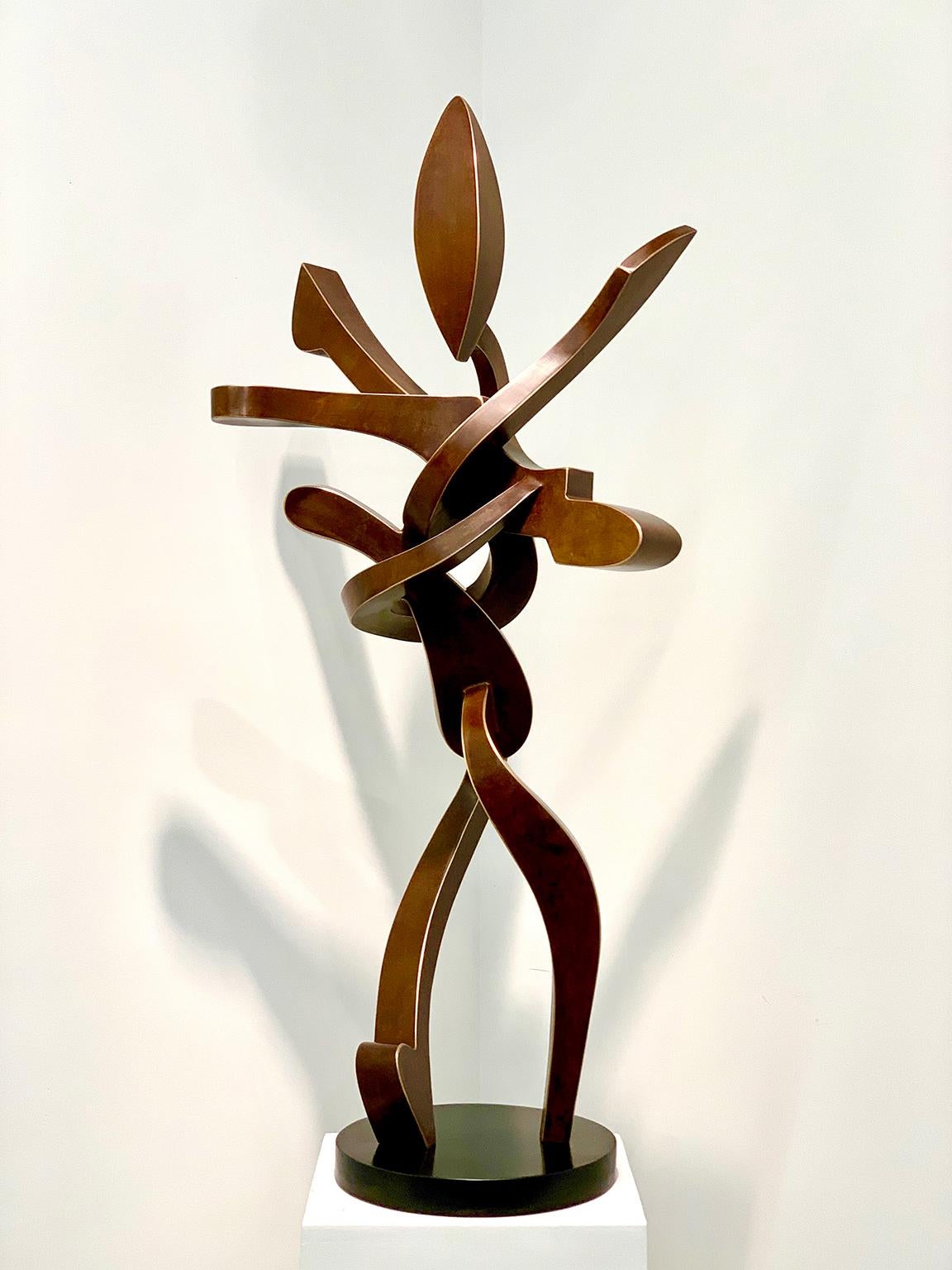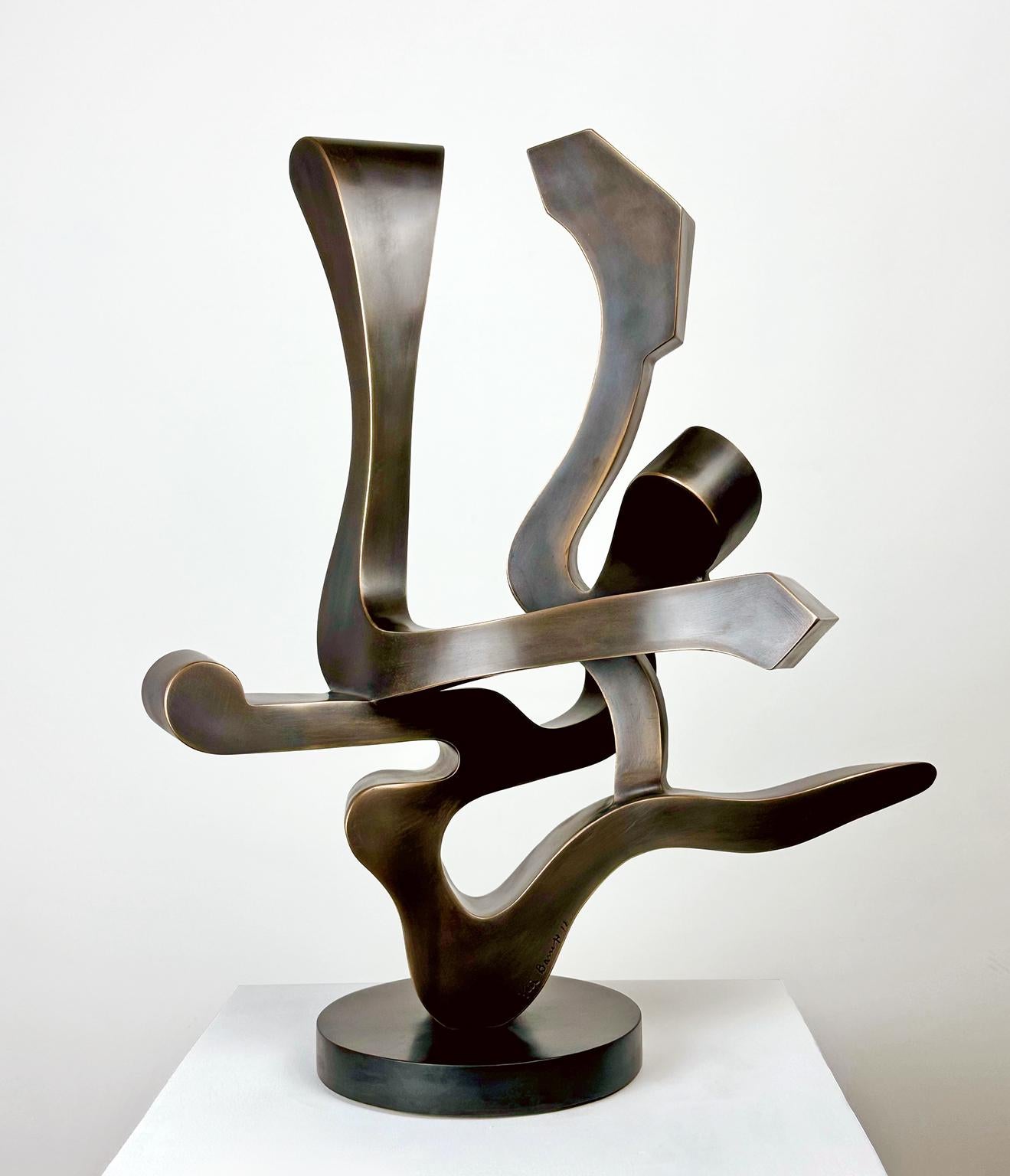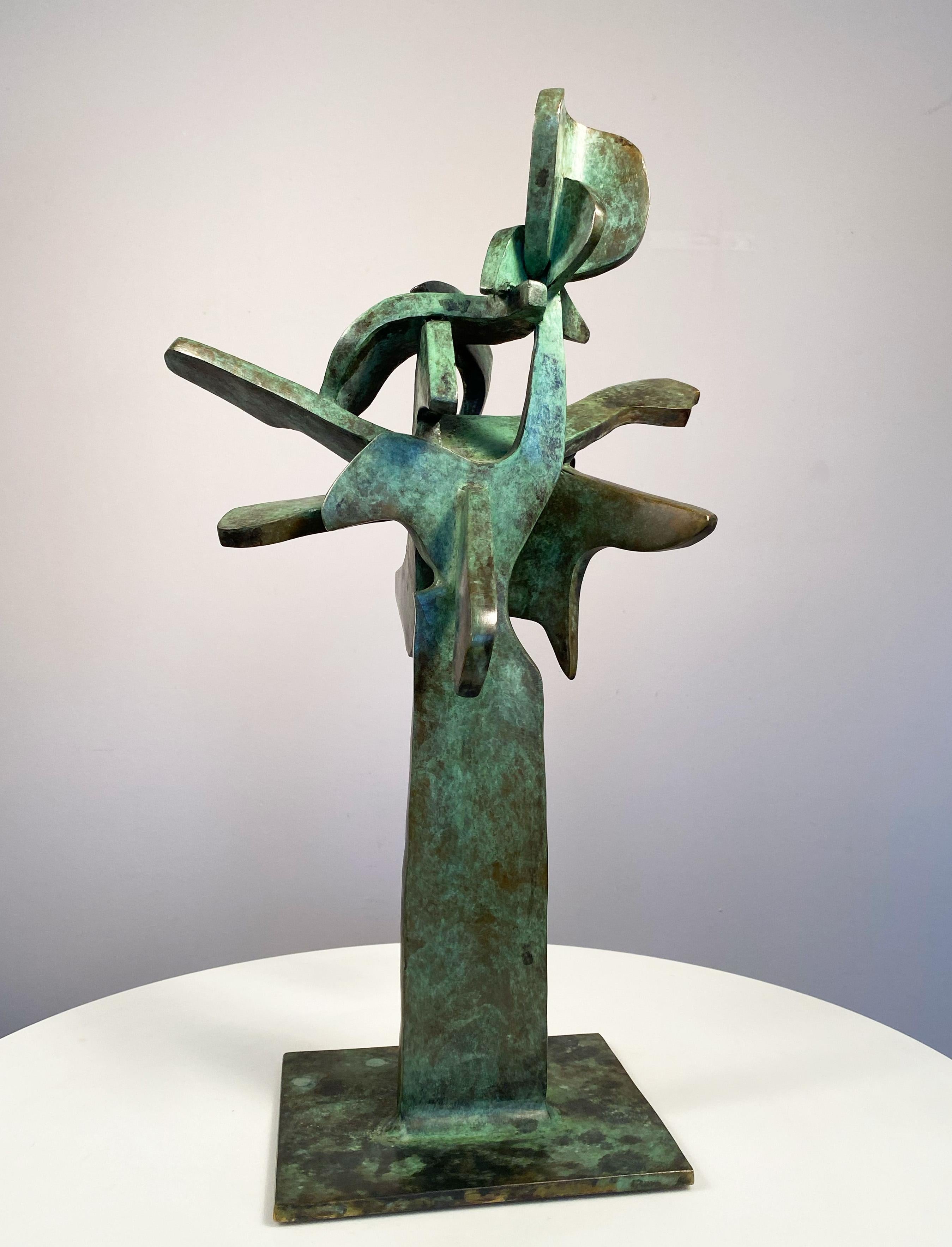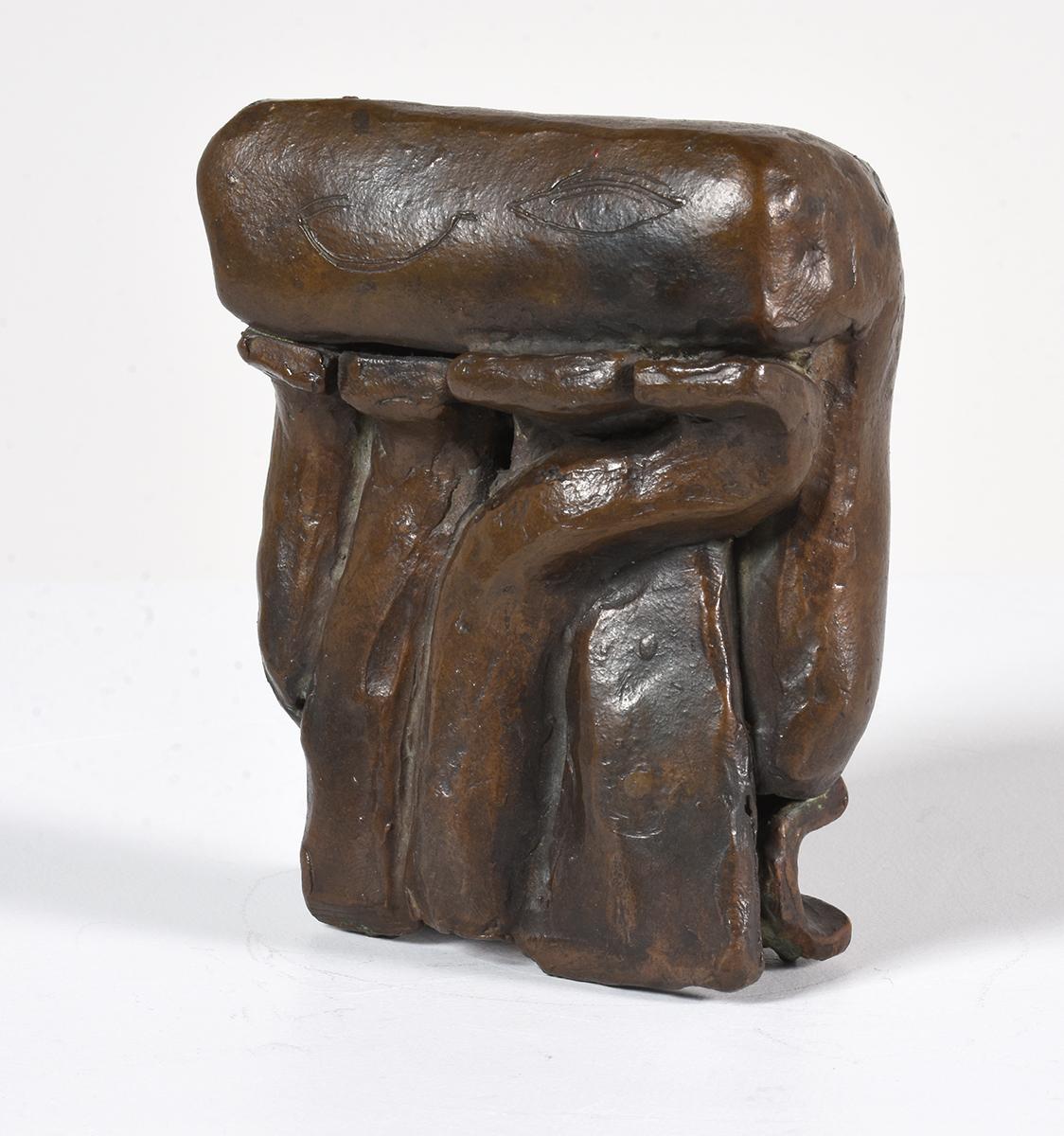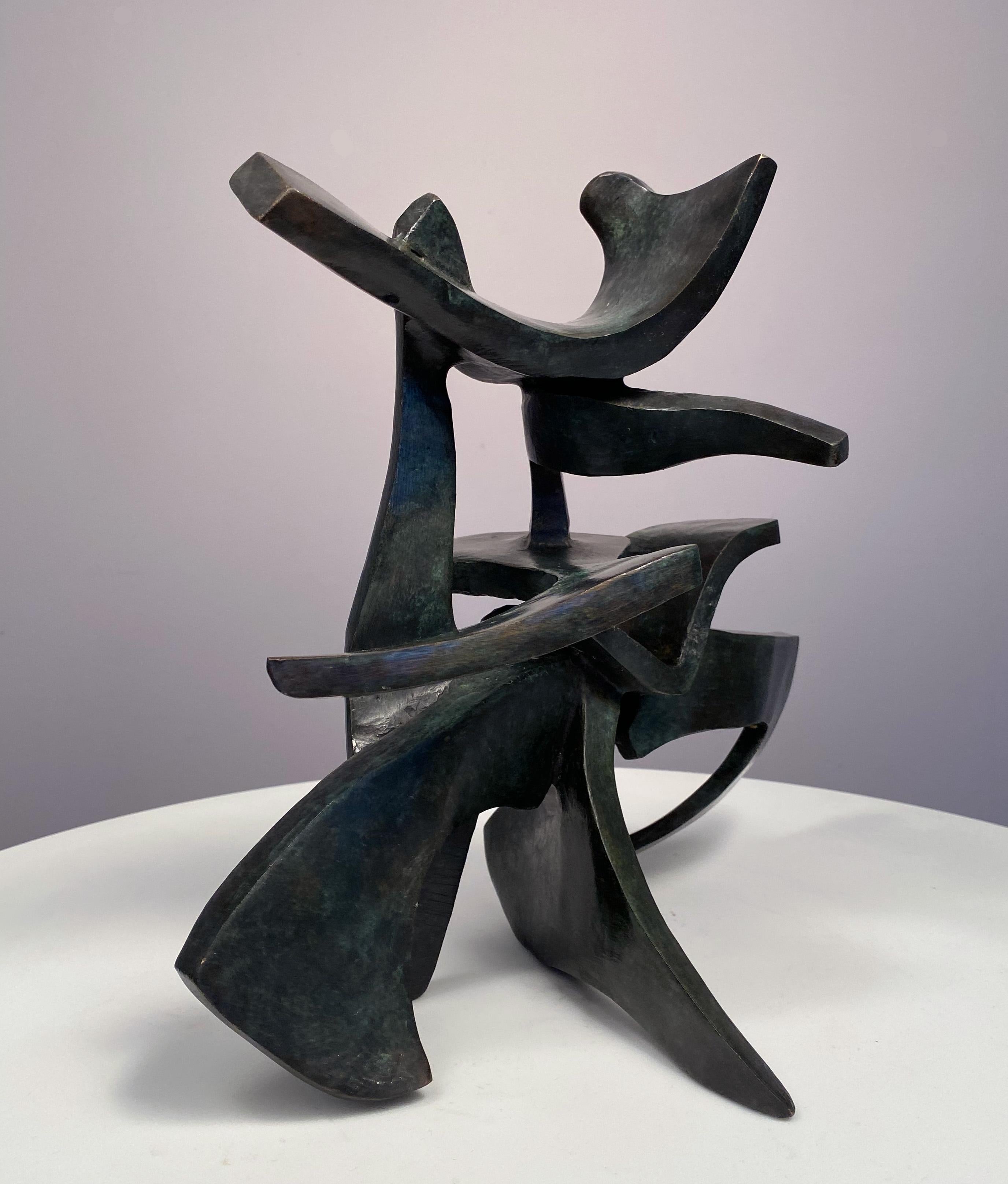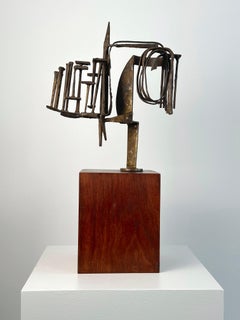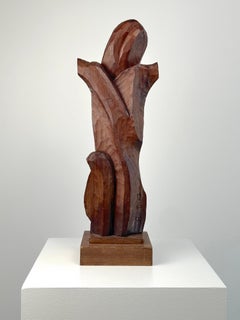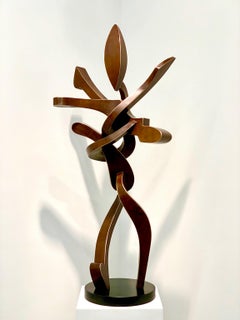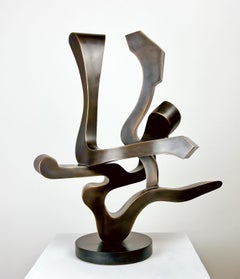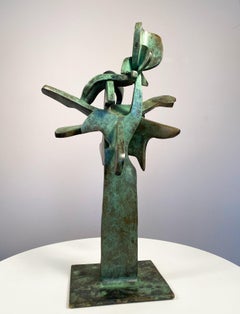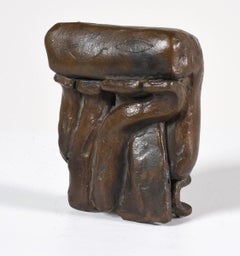Items Similar to Untitled (Organic abstract bronze sculpture)
Want more images or videos?
Request additional images or videos from the seller
1 of 8
Klaus IhlenfeldUntitled (Organic abstract bronze sculpture)ca. 1960
ca. 1960
$5,000
$8,00037% Off
£3,848.29
£6,157.2637% Off
€4,382.52
€7,012.0337% Off
CA$7,108.24
CA$11,373.1837% Off
A$7,726.89
A$12,363.0337% Off
CHF 4,049.57
CHF 6,479.3237% Off
MX$94,042.87
MX$150,468.5937% Off
NOK 50,974.45
NOK 81,559.1237% Off
SEK 47,899.39
SEK 76,639.0337% Off
DKK 32,728.66
DKK 52,365.8637% Off
About the Item
Klaus Ihlenfeld (b.1934). Untitled, ca. 1960. Welded bronze. 8" h.; 5.5 " w; 3.25" d (base). Signed with initial under base.
Provenance: Directly from estate of Harry Bertoia. The piece was a gift from Ihlenfeld and is a very early example created during Bertoia apprenticeship era.
Excellent condition.
Klaus Karl Otto IhlenfeldHe was born in Berlin, Germany in 1934. He studied art at the Hochschule für Bildende Künste and completed graduate work with the metal sculptor Hans Uhlmann. He visited the US in 1957 for the first time living in Durham, NC, where he befriended Dr. W. R. Valentiner, the Rembrandt authority and Director of the Museum of Art, Raleigh, NC. Through this friendship in 1960 he met and worked with the metal sculptor Harry Bertoia in Barto, PA.
He joined the Staempfli Gallery in NYC and entered in many group and one-man shows. He has been an Artist-in-Residence in Ogden, Utah; Huntington Museum of Art in West Virginia, Penn State University at University Park; the Colorado State University in Denver; and Shippensburg University. He has large commissions at Kutztown University, Pottstown Hospital, and a monumental relief sculpture at the Emigrant Savings Bank in NYC. He has traveled extensively in Spain, Greece, and Mexico. He is living and working on a farm in Barto, PA welding bronze and forged iron metal sculptures and painting watercolors.
Group Shows:
North Carolina Museum of Art in Raleigh, NC - 1957
Solomon R. Guggenheim Museum in New York City - 1962
Staempfli Gallery in New York City - 1962, 1964 and 1965
Gallery Ludwig Lange in West Berlin, Germany - 1977
Gallery Herbert Remmert and Dr. Barth in Dusseldorf in West Germany - 1981
Jack Savitt Gallery in Macungie, PA - 1981 and 1984
Heinz Ortleb Gallery, West Berlin, Germany - 1992
Central Bucks Chamber of Commerce Show at the James A. Michener Art Museum in Doylestown, PA - 1997
Berks Art Alliance Show at the Reading Art Museum in Reading, PA - 1997
Mayfair Festival of the Arts at the Allentown Art Museum - 1998
Baum School of Art in Allentown, PA - 1997
Schwenkfelder Library and Heritage Center Art Show in Pennsburg, PA - 2001
Reading Public Museum in Reading PA, 2014
Solo Shows:
Kutztown University in Kutztown, PA - 1960 and 1965
Allentown Art Museum in Allentown, PA - 1960 and 1961
Staempfli Gallery in New York City - 1962
Penn State University in University Park, PA - 1964 and 1972
Berks Art Alliance in Wyomissing, PA - 1966
Bertha Eccles Art Center in Ogden, Utah - 1967
Mansfield University in Mansfield, PA - 1967
Huntington Museum of Art in Huntington, WV - 1971
Shippensburg University in Shippensburg, PA - 1972
Albright College in Reading, PA - 1973
Ianuzzi Gallery in Scottsdale, AZ - 1974
Gallery Heimat 85 in West Berlin, Germany - 1977
Jack Savitt Gallery in Macungie, PA - 1981
College Misericordia in Dallas, PA - 1983
Schwenkfelder Library and Heritage Center in Pennsburg, PA, 2013
Periodical Reference:
Kaye, Ellen "The Obsessive Collector," Philadelphia Inquirer Sunday Magazine Sptember 21, 1986 pp. 32-33.
Chronology:
1-30-1934 Born in Berlin, Germany. Father, Kurt Ihlenfeld, Lutheran pastor, novelist, critic and publisher was born in 1901 in Colmar, Alsace Lorain. Mother, Annie Stuhlmann, was born in 1905 in Breslau, Lower Silesia.
1940 - 1950 Public schools in Berlin; Löwen, Lower Silesia; Coswig, Radebeul, Glaubitz, Saxony. Königin Luise-Gymnasium in Dahlem, Berlin. First artworks, drawings and paintings; few sculptures.
1950 - 1956 Studied at the Hochschule für Bildende Künste in West Berlin, Germany. Graduate work with metal sculptor Hans Uhlmann. For 2 years maintained own studio at the Academy. Friendship with writer Günter Grass, and painter F. S. Sonnenstern. Met painters: Max Pechstein, Karl Schmidt-Rottluff, Carl Hofer, Max Kaus, and sculptors: Bernhard Heiliger, Renee Sintenis, and Richard Scheibe. Opened own gallery in the Kurfürstendam area of Berlin.
1954 Traveled to West Germany, France, Barcelona, Spain (Balearic Islands), and Menorca for 3 months.
1957 First visit to the United States in Durham, NC. Participated in a group show at the Museum of Art, Raleigh, NC. Friendship with Dr. W. R. Valentiner, the Rembrandt authority and Director of the Museum of Art, Raleigh, NC. Work with metal sculptor Harry Bertoia in Bally, PA. Started own metal sculptures in Bertoia Studio. Traveled to Mexico and throughout the US. Visited Monte Alban, and Mitla-Oaxaca. Started collecting works of pre-Columbian art. Also African and South Pacific works of art and the works of children.
1958 Returned to West Berlin, Germany to open own workshop and gallery. Cooperation with his brother Bertram Ihlenfeld and brother-in-law, violinist Heinz Ortleb. Precise metal sculptures in various medias.
1959: Motion picture of the development of sculptures: Spiel in Stahl (Play in Steel), filmed by Dr. Hans Cürlis shown at the Bergamo Film Festival in Italy, in West Germany, and German Embassies in South America.
1960 Second visit to the United States. Cooperation with sculptor Harry Bertoia in Bally, PA. Friendship with Brigitta Valentiner Bertoia. Worked on large commissions. Met painter Willem DeKoonig, gallerist Georg W. Staempfli in New York City, and furniture maker George Nakashima in New Hope, PA. First one-man show of sculptures at Kutztown State College, Kutztown, PA. One-man show of sculptures at the Allentown Museum of Art under Director Hirsch.
1961 Traveled and studied archeological sites in Mexico (Monte Alban, Mitla-Oaxaca; Colima, Nayarit, Sinaloa, Patzcuaro, etc.). Collected pre-Columbian art in Mexico and New York City. Second one-man show at the Allentown Museum of Art (sculptures) under Director Caldwell.
1962 One-man show at Staempfli Gallery in New York City. Participated in various group shows at the gallery: "Twenty Sculptors" and "Recent Acquisitions". Met artists Marcel Duchamp and Salvador Dali; sculptors Alexander Calder and Alexander Lieberman. Participated in a major exhibition at the Solomon R. Guggenheim Museum in New York City entitled "Modern Sculpture from the Joseph H. Hirshhorn Collection".
1963 Married Patricia A. Lambert of Springfield, PA. Harry Bertoia was their best man.
1964 One-man show at the Pennsylvania State University, University Park, PA and a group show "Stone, Wood and Metal" at Staemplfi Gallery in New York City. First child, Paul Vincent born.
1965 Entered group show at Staempfli Gallery "Stone and Crystal". One-man show of graphics at Kutztown State Teachers College in Kutztown, PA. One-man show at Wyomissing Art Alliance, Reading, PA.
1966 Commissioned for a fountain sculpture at Kutztown State Teachers College, Kutztown, PA. Birth of twins, Phillip Sydney and Naomi Andrea.
1967 Artist-in-Residence at the Bertha Eccles Art Center, Ogden, Utah (received a grant from the National Endowment of the Arts). Met sculptor Larry Elsner. One-man show at Mansfield State College, Mansfield, PA. Fourth child born, Douglas Robinson.
1968 - 1969 Commissioned to create a large relief sculpture for the Emigrant Savings Bank at 5 East 42nd Street in Manhattan, New York City entitled: Heavenly Bodies, 250 ft. X 32 ft. (weighing 8 tons). Moved to the estate "Iron Masters Mansion", Barto, PA.
1970 - 1971 Artist-in-Residence at the Huntington Museum of Art, Huntington, WV (received a grant from the National Endowment of the Arts). One-man show at the Huntington Museum of Art. A movie was made of the exhibition by the Huntington Television Station. Met A. Moretti, sculptor of glass figures. One-man show at the old Sears and Roebuck mansion in Haverford, PA.
1971 - 1972 Artist-in-Residence at the Pennsylvania State University, University Park, PA (received a grant from the National Endowment of the Arts). Classes for drawing and experimental sculpture. One-man show at the Chambers Building and the Hetzel Union Building. Also Artist-in-Residence at Shippensburg State College, Shippensburg, PA. Commissioned to execute a sculpture for the new Library at the Shippensburg State College. Death of father, Kurt Ihlenfeld.
1973 Invitation to lecture and work with sculpture classes at Colorado State University, Denver, Colorado. One-man show at Albright College, Reading, PA.
1974 - 1976 Years of increased studies and work. Acquisition of a farm in Barto, PA. Built a new workshop. Works and lives with his wife and four children at the Barto, PA farm. New sculptures in iron, bronze, brass and wood. Traveled to Belgium, West Germany and Switzerland. One-man show at Gallery Heimat 85, West Berlin, Germany. One-man show at the Ianuzzi Gallery, Scottsdale, Arizona. Friendship with sculptor Tom Althouse and paintress Jane Mitchell.
1977 - 1981 Traveled to West Berlin. Works exhibited at Gallery Heimat 85, West Berlin. Also exhibited at Gallery Ludwig Lange. New workshop opened at parent's house in West Berlin. Many sculptures in steel, iron and bronze, some are represented at the Gallery Herbert Remmert and Dr. Barth, Düsseldorf, West Germany. Visited the Island of Korfu in Greece. New graphics. First visit to Italy. A fire at the farm destroyed two buildings, also 38 sculptures (created from 1950 to 1979), reliefs, graphics, correspondences, and various art collections.
1981 - 1984 One-man show and group shows at the Jack Savitt Gallery, Macungie, PA. One-man show at Misericordia College, Dallas, PA.
1984 - 1985 Change of direction. Painting in watercolor dominates sculptural work. Also greater interest in collecting other artists' work. One-man show at the James A. Caplan estate in Villanova, PA.
1989 Represented in the June 1989 Colonial Homes magazine. The article and photographs described the artist's life and his collections.
1992 Traveled to Europe, mainly living and working in Germany and Belgium. One-man show in Liegé, Belgium. Sculptures, drawings and paintings shown at the Heinz Ortleb Gallery, Berlin. Death of mother, Annie Ihlenfeld, in Berlin.
1994 - 1996 Restored a large barn at the farm with his son Phillip for extensive art collections and completed sculptures. Created sculpture garden at farm.
1996 Created many new bronze and brass sculptures during the winter months. Participated in the Central Bucks Chamber of Commerce Sculpture Show. Study tour to Bermuda with his wife. The semi-tropical plants and landscapes inspired new works.
1997: Traveled, study-tour, to St. Lucia, near Martinique, in the West Indies with his wife. This tropical environment was most inspiring. Participated in the Central Bucks Chamber of Commerce Sculpture Show at the James A. Michener Art Museum in Doylestown from June 13 to September 7, 1997.
1998 Entered the Berks County Art Alliance juried art show in the fall at the Reading Art Museum, Reading, PA.
1999 Travels and studies with family members of ruins near Oaxaca City, Oaxaca, Mexico (Monte Alban, Mitla, Dainzu, Teotitlan del Valle, Lambityeco, San Jose El Mogote, Yagul), the Rufino Tamayo Museum of Pre-Columbian Art, and the Regional Museum of Anthropology in Oaxaca City, in May. This is one of the most productive years in metal sculpting - forged iron and steel (many large scale works) all welded, new watercolors and art acquisitions.
2000 Sculptures entered in the Baum School Art Auction, Allentown, PA.
2001 Entered a group show of sculpture and paintings at the Schwenkfelder Library and Heritage Center, Pennsburg, PA. Continues to create new sculptures in iron, bronze, brass and wood. Also has continued to produce a wide variety of watercolor & other graphics large and small.
2002 Study tour to the Key West, Cozumel, Tulum, Belize and Nassau. Continues to produce many sculptures in bronze and iron.
2003 - 2004 Visited Niagara Falls, the Finger Lakes, Thousand Islands, Rockport, Maine and Concord, Massachusetts. Many inspirations for water colors and sculptures.
2005 - Exploring Maryland during the summer. First grandchild born in July, which was an extraordinary event. Painting many watercolors and continuing to work in forged iron.
2006
Sculptures entered in the PA Sinfonia Orchestra Art Auction, Allentown, PA. Continues to produce a wide variety of watercolors and bronze sculptures. Acquired over 200 African artifacts. Sculptures sold at David Rago Auctions in Lambertville, NJ.
2007-2008
Sculptures entered in the Baum School of Art Auction, Allentown, PA. Second grandchild born in July 2008 which was another spectacular event. Continues to produce a wide variety of watercolors, forged iron, and bronze sculptures. Acquired many old African artifacts. Sculptures sold at Sanford Alderfer Auctions in Hatfield, PA, and David Rago Auctions in Lambertville, NJ.
2009-2012
Exploring and enjoying Maryland and "Amish-land" Lancaster, PA locations during the summer. Continues to produce a wide variety of watercolors, jewelry, mixed-media, forged iron, and bronze sculptures. Sculptures sold at David Rago Auctions in Lambertville, NJ; Skinner Auctions in Boston; Wright in Chicago; Sotheby's in New York City (the Robert Isabell collection); Galerie Bassenge, Berlin, Germany; Samuel T. Freeman & Co, Philadelphia, PA; Alderfer Auctions in Hatfield, PA; and others from many collectors of his sculptures.
2013
Sculptures, combined with selections from his collection of African, American Indian, South Pacific and Pre-Columbian works of art are exhibited at the Schwenkfelder Library & Heritage Center in Pennsburg, PA from June 30 to September 29. His decades-long collection of art from all corners of the globe is a perfect complement to his organic modernist sculpture.
2014
A major exhibit at the Reading Public Museum in Reading, PA from February 8 to May 11 entitled "Ihlenfeld/Bertoia: an Artistic Friendship". The exhibition includes more than 60 works from all stages of Ihlenfeld's career including examples made from welded bronze and found objects. Additional works on paper and sculpture by Harry Bertoia help tell the story of collaboration and artistic influence.
INSTITUTIONAL COLLECTIONS
Everhart Museum of Art, Scranton, PA
Allentown Art Museum, Allentown, PA
Misericordia College, Dallas, PA
Hirshhorn Museum, Washington, D.C.
Huntington Museum, Huntington, W. Virginia
Kutztown University, Kutztown, PA
Penn State University, University Park, PA
Phillips Academy, Andover, Massachusetts
Shippensburg University, Shippensburg, PA
Jordan Schnitzer Museum of Art, University of Oregon, Eugene
Partial List of Collections in the US and Europe:
The Late Vice President Nelson A. Rockefeller, Albany, NY; Joseph H. Hirshhorn, Washington, DC; Cultural Ambassador, Dr. Bruno E. Werner, Washington, DC; J. David Thompson, Pittsburgh, PA; Billy Wilder, Hollywood, CA; Ambassador Ferguson, Washington, DC; Dr. W. R. Valentiner, Raleigh, NC; Harry Bertoia and Brigitta Valentiner Bertoia, Barto, PA; David Steine, New York City; William A. and Muriel Rand, New York City; Robert Sarnoff, Jr., New York City; Georg W. Staempfli Gallery, New York City; Neiman Marcus, Dallas, TX; Sol Brody, Philadelphia, PA; Jack and Muriel Wolgin, Philadelphia, PA; Phillip and Muriel Berman, Allentown, PA; James Caplan, Villanova, PA; Anatol Holt, Milan, Italy; Houston Scott, Newport, RI; Mara Ianuzzi Gallery, Scottsdale, AZ; Bertram Ihlenfeld, Monterey, CA; Interstate Container Corporation, New York City; Robert Forsyth, Denver, CO; Dr. Howard Sokol, Pottstown, PA; Dr. Spencer Richmond, Pottstown, PA; Jon Harris Insurance Company, New York City; American Republic Insurance Company, New York City; Larry Katz, Philadelphia, PA; Curtis Brooks, Connecticut; Dr. Jerry Dersch, Reading, PA; Frank Mininni, Cincinnati, OH; Jack Savitt Gallery, Macungie, PA; Pearl Fox Gallery, Philadelphia, PA; Morris and Robin Satinsky, Villanova, PA; Hans Newman, Caracas, Venezuela; Dr. Emile Leclercq, Liegé, Belgium; Chester A. Beatty, London, England; The Laventhol Family, California; Wolfgang Boetcher, Berlin, Germany; Peter Oettel, Berlin, Germany
- Creator:Klaus Ihlenfeld (1934, American)
- Creation Year:ca. 1960
- Dimensions:Height: 8 in (20.32 cm)Width: 5.5 in (13.97 cm)Depth: 3.25 in (8.26 cm)
- Medium:
- Movement & Style:
- Period:
- Condition:
- Gallery Location:Wilton Manors, FL
- Reference Number:1stDibs: LU245214389562
About the Seller
4.9
Platinum Seller
Premium sellers with a 4.7+ rating and 24-hour response times
Established in 2007
1stDibs seller since 2015
429 sales on 1stDibs
Typical response time: 4 hours
- ShippingRetrieving quote...Shipping from: Wilton Manors, FL
- Return Policy
Authenticity Guarantee
In the unlikely event there’s an issue with an item’s authenticity, contact us within 1 year for a full refund. DetailsMoney-Back Guarantee
If your item is not as described, is damaged in transit, or does not arrive, contact us within 7 days for a full refund. Details24-Hour Cancellation
You have a 24-hour grace period in which to reconsider your purchase, with no questions asked.Vetted Professional Sellers
Our world-class sellers must adhere to strict standards for service and quality, maintaining the integrity of our listings.Price-Match Guarantee
If you find that a seller listed the same item for a lower price elsewhere, we’ll match it.Trusted Global Delivery
Our best-in-class carrier network provides specialized shipping options worldwide, including custom delivery.More From This Seller
View AllUntitled (Organic abstract bronze sculpture)
Located in Wilton Manors, FL
Klaus Ihlenfeld (b.1934)
Untitled (Flower Form), sculpted phosphor bronze-coated copper sounding sculpture, early 1970s.
Exhibited: Klaus Ihlenfeld - Recent Sculpture at Albright College - Campus Center Gallery from Feb. 18 - March 18, 1973.. Welded bronze. 15 h x 12.5 inches w. Signed with initial on base.
Provenance: Albright College Museum collection.
Excellent condition.
Klaus Karl Otto Ihlenfeld. He was born in Berlin, Germany in 1934. He studied art at the Hochschule für Bildende Künste and completed graduate work with the metal sculptor Hans Uhlmann. He visited the US in 1957 for the first time living in Durham, NC, where he befriended Dr. W. R. Valentiner, the Rembrandt authority and Director of the Museum of Art, Raleigh, NC. Through this friendship in 1960 he met and worked with the metal sculptor Harry Bertoia in Barto, PA.
He joined the Staempfli Gallery in NYC and entered in many group and one-man shows. He has been an Artist-in-Residence in Ogden, Utah; Huntington Museum of Art in West Virginia, Penn State University at University Park; the Colorado State University in Denver; and Shippensburg University. He has large commissions at Kutztown University, Pottstown Hospital, and a monumental relief sculpture at the Emigrant Savings Bank in NYC. He has traveled extensively in Spain, Greece, and Mexico. He is living and working on a farm in Barto, PA welding bronze and forged iron metal sculptures and painting watercolors.
Group Shows:
North Carolina Museum of Art in Raleigh, NC - 1957
Solomon R. Guggenheim Museum in New York City - 1962
Staempfli Gallery in New York City - 1962, 1964 and 1965
Gallery Ludwig Lange in West Berlin, Germany - 1977
Gallery Herbert Remmert and Dr. Barth in Dusseldorf in West Germany - 1981
Jack Savitt Gallery in Macungie, PA - 1981 and 1984
Heinz Ortleb Gallery, West Berlin, Germany - 1992
Central Bucks Chamber of Commerce Show at the James A. Michener Art Museum in Doylestown, PA - 1997
Berks Art Alliance Show at the Reading Art Museum in Reading, PA - 1997
Mayfair Festival of the Arts at the Allentown Art Museum - 1998
Baum School of Art in Allentown, PA - 1997
Schwenkfelder Library and Heritage Center Art Show in Pennsburg, PA - 2001
Reading Public Museum in Reading PA, 2014
Solo Shows:
Kutztown University in Kutztown, PA - 1960 and 1965
Allentown Art Museum in Allentown, PA - 1960 and 1961
Staempfli Gallery in New York City - 1962
Penn State University in University Park, PA - 1964 and 1972
Berks Art Alliance in Wyomissing, PA - 1966
Bertha Eccles Art Center in Ogden, Utah - 1967
Mansfield University in Mansfield, PA - 1967
Huntington Museum of Art in Huntington, WV - 1971
Shippensburg University in Shippensburg, PA - 1972
Albright College in Reading, PA - 1973
Ianuzzi Gallery in Scottsdale, AZ - 1974
Gallery Heimat 85 in West Berlin, Germany - 1977
Jack Savitt Gallery in Macungie, PA - 1981
College Misericordia in Dallas, PA - 1983
Schwenkfelder Library and Heritage Center in Pennsburg, PA, 2013
Periodical Reference:
Kaye, Ellen "The Obsessive Collector," Philadelphia Inquirer Sunday Magazine Sptember 21, 1986 pp. 32-33.
Chronology:
1-30-1934 Born in Berlin, Germany. Father, Kurt Ihlenfeld, Lutheran pastor, novelist, critic and publisher was born in 1901 in Colmar, Alsace Lorain. Mother, Annie Stuhlmann, was born in 1905 in Breslau, Lower Silesia.
1940 - 1950 Public schools in Berlin; Löwen, Lower Silesia; Coswig, Radebeul, Glaubitz, Saxony. Königin Luise-Gymnasium in Dahlem, Berlin. First artworks, drawings and paintings; few sculptures.
1950 - 1956 Studied at the Hochschule für Bildende Künste in West Berlin, Germany. Graduate work with metal sculptor Hans Uhlmann. For 2 years maintained own studio at the Academy. Friendship with writer Günter Grass, and painter F. S. Sonnenstern. Met painters: Max Pechstein, Karl Schmidt-Rottluff, Carl Hofer, Max Kaus, and sculptors: Bernhard Heiliger, Renee Sintenis, and Richard Scheibe. Opened own gallery in the Kurfürstendam area of Berlin.
1954 Traveled to West Germany, France, Barcelona, Spain (Balearic Islands), and Menorca for 3 months.
1957 First visit to the United States in Durham, NC. Participated in a group show at the Museum of Art, Raleigh, NC. Friendship with Dr. W. R. Valentiner, the Rembrandt authority and Director of the Museum of Art, Raleigh, NC. Work with metal sculptor Harry Bertoia in Bally, PA. Started own metal sculptures in Bertoia Studio. Traveled to Mexico and throughout the US. Visited Monte Alban, and Mitla-Oaxaca. Started collecting works of pre-Columbian art. Also African and South Pacific works of art and the works of children.
1958 Returned to West Berlin, Germany to open own workshop and gallery. Cooperation with his brother Bertram Ihlenfeld and brother-in-law, violinist Heinz Ortleb. Precise metal sculptures in various medias.
1959: Motion picture of the development of sculptures: Spiel in Stahl (Play in Steel), filmed by Dr. Hans Cürlis shown at the Bergamo Film Festival in Italy, in West Germany, and German Embassies in South America.
1960 Second visit to the United States. Cooperation with sculptor Harry Bertoia in Bally, PA. Friendship with Brigitta Valentiner Bertoia. Worked on large commissions. Met painter Willem DeKoonig, gallerist Georg W. Staempfli in New York City, and furniture maker George Nakashima in New Hope, PA. First one-man show of sculptures at Kutztown State College, Kutztown, PA. One-man show of sculptures at the Allentown Museum of Art under Director Hirsch.
1961 Traveled and studied archeological sites in Mexico (Monte Alban, Mitla-Oaxaca; Colima, Nayarit, Sinaloa, Patzcuaro, etc.). Collected pre-Columbian art in Mexico and New York City. Second one-man show at the Allentown Museum of Art (sculptures) under Director Caldwell.
1962 One-man show at Staempfli Gallery in New York City. Participated in various group shows at the gallery: "Twenty Sculptors" and "Recent Acquisitions". Met artists Marcel Duchamp and Salvador Dali; sculptors Alexander Calder and Alexander Lieberman. Participated in a major exhibition at the Solomon R. Guggenheim Museum in New York City entitled "Modern Sculpture from the Joseph H. Hirshhorn Collection".
1963 Married Patricia A. Lambert of Springfield, PA. Harry Bertoia was their best man.
1964 One-man show at the Pennsylvania State University, University Park, PA and a group show "Stone, Wood and Metal" at Staemplfi Gallery in New York City. First child, Paul Vincent born.
1965 Entered group show at Staempfli Gallery "Stone and Crystal". One-man show of graphics at Kutztown State Teachers College in Kutztown, PA. One-man show at Wyomissing Art Alliance, Reading, PA.
1966 Commissioned for a fountain sculpture at Kutztown State Teachers College, Kutztown, PA. Birth of twins, Phillip Sydney and Naomi Andrea.
1967 Artist-in-Residence at the Bertha Eccles Art Center, Ogden, Utah (received a grant from the National Endowment of the Arts). Met sculptor Larry Elsner. One-man show at Mansfield State College, Mansfield, PA. Fourth child born, Douglas Robinson.
1968 - 1969 Commissioned to create a large relief sculpture for the Emigrant Savings Bank at 5 East 42nd Street in Manhattan, New York City entitled: Heavenly Bodies, 250 ft. X 32 ft. (weighing 8 tons). Moved to the estate "Iron Masters Mansion", Barto, PA.
1970 - 1971 Artist-in-Residence at the Huntington Museum of Art, Huntington, WV (received a grant from the National Endowment of the Arts). One-man show at the Huntington Museum of Art. A movie was made of the exhibition by the Huntington Television Station. Met A. Moretti, sculptor of glass figures. One-man show at the old Sears and Roebuck mansion in Haverford, PA.
1971 - 1972 Artist-in-Residence at the Pennsylvania State University, University Park, PA (received a grant from the National Endowment of the Arts). Classes for drawing and experimental sculpture. One-man show at the Chambers Building and the Hetzel Union Building. Also Artist-in-Residence at Shippensburg State College, Shippensburg, PA. Commissioned to execute a sculpture for the new Library at the Shippensburg State College. Death of father, Kurt Ihlenfeld.
1973 Invitation to lecture and work with sculpture classes at Colorado State University, Denver, Colorado. One-man show at Albright College, Reading, PA.
1974 - 1976 Years of increased studies and work. Acquisition of a farm in Barto, PA. Built a new workshop. Works and lives with his wife and four children at the Barto, PA farm. New sculptures in iron, bronze, brass and wood. Traveled to Belgium, West Germany and Switzerland. One-man show at Gallery Heimat 85, West Berlin, Germany. One-man show at the Ianuzzi Gallery, Scottsdale, Arizona. Friendship with sculptor Tom Althouse and paintress Jane Mitchell.
1977 - 1981 Traveled to West Berlin. Works exhibited at Gallery Heimat 85, West Berlin. Also exhibited at Gallery Ludwig Lange. New workshop opened at parent's house in West Berlin. Many sculptures in steel, iron and bronze, some are represented at the Gallery Herbert Remmert and Dr. Barth, Düsseldorf, West Germany. Visited the Island of Korfu in Greece. New graphics. First visit to Italy. A fire at the farm destroyed two buildings, also 38 sculptures (created from 1950 to 1979), reliefs, graphics, correspondences, and various art collections.
1981 - 1984 One-man show and group shows at the Jack Savitt Gallery, Macungie, PA. One-man show at Misericordia College, Dallas, PA.
1984 - 1985 Change of direction. Painting in watercolor dominates sculptural work. Also greater interest in collecting other artists' work. One-man show at the James A. Caplan estate in Villanova, PA.
1989 Represented in the June 1989 Colonial Homes magazine. The article and photographs described the artist's life and his collections.
1992 Traveled to Europe, mainly living and working in Germany and Belgium. One-man show in Liegé, Belgium. Sculptures, drawings and paintings shown at the Heinz Ortleb Gallery, Berlin. Death of mother, Annie Ihlenfeld, in Berlin.
1994 - 1996 Restored a large barn at the farm with his son Phillip for extensive art collections and completed sculptures. Created sculpture garden at farm.
1996 Created many new bronze and brass sculptures during the winter months. Participated in the Central Bucks Chamber of Commerce Sculpture Show. Study tour to Bermuda with his wife. The semi-tropical plants and landscapes inspired new works.
1997: Traveled, study-tour, to St. Lucia, near Martinique, in the West Indies with his wife. This tropical environment was most inspiring. Participated in the Central Bucks Chamber of Commerce Sculpture Show at the James A. Michener Art Museum in Doylestown from June 13 to September 7, 1997.
1998 Entered the Berks County Art Alliance juried art show in the fall at the Reading Art Museum, Reading, PA.
1999 Travels and studies with family members of ruins near Oaxaca City, Oaxaca, Mexico (Monte Alban, Mitla, Dainzu, Teotitlan del Valle, Lambityeco, San Jose El Mogote, Yagul), the Rufino Tamayo Museum of Pre-Columbian Art, and the Regional Museum of Anthropology in Oaxaca City, in May. This is one of the most productive years in metal sculpting - forged iron and steel (many large scale works) all welded, new watercolors and art acquisitions.
2000 Sculptures entered in the Baum School Art Auction, Allentown, PA.
2001 Entered a group show of sculpture and paintings at the Schwenkfelder Library and Heritage Center, Pennsburg, PA. Continues to create new sculptures in iron, bronze, brass and wood. Also has continued to produce a wide variety of watercolor & other graphics large and small.
2002 Study tour to the Key West, Cozumel, Tulum, Belize and Nassau. Continues to produce many sculptures in bronze and iron.
2003 - 2004 Visited Niagara Falls, the Finger Lakes, Thousand Islands, Rockport, Maine and Concord, Massachusetts. Many inspirations for water colors and sculptures.
2005 - Exploring Maryland during the summer. First grandchild born in July, which was an extraordinary event. Painting many watercolors and continuing to work in forged iron.
2006
Sculptures entered in the PA Sinfonia Orchestra Art Auction, Allentown, PA. Continues to produce a wide variety of watercolors and bronze sculptures. Acquired over 200 African artifacts. Sculptures sold at David Rago Auctions...
Category
Mid-20th Century Abstract Abstract Sculptures
Materials
Bronze
Untitled abstract expressionist mid-century modern sculpture
By Thomas Morin
Located in Wilton Manors, FL
Thomas Morin (1934-2017)
Untitled, 1962.
Cast iron on wood base. Cast sculpture measures 24 x 7 x 5 inches and weighs 49 lbs. Overall measures 26 inches tall on wood base.
Proc...
Category
Mid-20th Century Abstract Expressionist Abstract Sculptures
Materials
Iron
$2,400 Sale Price
40% Off
Banner (abstract expressionist sculpture, Tulsa OK artist)
Located in Wilton Manors, FL
Duayne Hatchett ((1925-2015). Banner, 1958. Welded metal, sculpture measures 11 h. x 9 w. x 3.75 d. inches. Measuring a total of 17.5 inch high on base. Base measures 5.5 x 5.5 by 6 ...
Category
Mid-20th Century Abstract Expressionist Abstract Sculptures
Materials
Metal
$4,500 Sale Price
43% Off
Abstract Figure
By Raul Diaz
Located in Wilton Manors, FL
Raul Diaz (Argentina, b.1950). Abstract Figure, ca. 1970s. Canved Walnut. Measures 17 inches tall including wood base. Carved signature in lower region. Excellent condition.
An ear...
Category
1970s Abstract Expressionist Abstract Sculptures
Materials
Walnut
$900 Sale Price
25% Off
Four Figures
Located in Wilton Manors, FL
Four Figures, ca. 1960. Welded bronze, 14.5 x 9.75 x 3 inches. Signed at base.
Edgar Tafur, born and raised in Colombia, was first trained as an architect at the University of the ...
Category
Mid-20th Century Abstract Abstract Sculptures
Materials
Bronze
$4,500 Sale Price
43% Off
Two Untitled Compositions
Located in Wilton Manors, FL
Fumio Otani (Japanese, 1929-1995). Untitled and Untitled, ca, 1965. Cast and polished steel.
Smaller composition measures 14.75 x 7.75 x 1.5 inches.
Larger composition measures 16...
Category
Mid-20th Century Abstract Expressionist Abstract Sculptures
Materials
Steel
$14,400 Sale Price
20% Off
You May Also Like
"Flare" by Kevin Barrett, Abstract Bronze Metal Sculpture, Tabletop Size
By Kevin Barrett
Located in New York, NY
"Flare" by Kevin Barrett
Unique bronze, abstract tabletop sculpture
Barrett is noted for creating unique, rhythmic, abstract indoor and outdoor sculpture and wall reliefs.
Bronze M...
Category
2010s Abstract Abstract Sculptures
Materials
Metal, Bronze
"Guided Spirit" (maquette), Abstract, Bronze Metal Sculpture, Tabletop Size
By Kevin Barrett
Located in New York, NY
"Guided Spirit" (maquette) Abstract, Tabletop Size, Metal Sculpture by Kevin Barrett
Bronze
Kevin Barrett is noted for creating unique, rhythmic, abstract indoor and outdoor sculptu...
Category
2010s Abstract Abstract Sculptures
Materials
Metal, Bronze
Lyra Series 10, indoor sculpture
By Bill Barrett
Located in New York, NY
Barrett is one of America's outstanding living sculptors. A sculptor who works on large scale and major commission and outdoor works, his smaller indoor maquettes have been avidly c...
Category
2010s Abstract Abstract Sculptures
Materials
Bronze
Eugene Caples "Bronze Sculpture I" Abstract Bronze Sculpture
By Eugene Caples
Located in Detroit, MI
This small exquisite "Bronze Sculpture I" is in excellent condition and a perfect example of Eugene Caples craftsmanship. Although it is mainly abstract, there are bits that look figurative either an arm or a leg attempting to emerge from a fold or attempting to hold a pose such as in yoga. It cries out to be touched and held, looked at and caressed. The beautiful patina on the surface gives voice to the many hands that have done these things.
Eugene Caples is a designer and craftsman who worked in Kansas City in the 1960s and later through the early 21st century. He attended the Kansas City Art Institute, earning his Bachelors of Fine Arts in Industrial Design in 1959. In 1963 he was accepted to Cranbrook Academy of Art, Bloomfield Hills, Michigan. The Cranbrook Academy of Art was designed by architect and faculty member, Eliel Saarinen who collaborated with Charles and Ray Eames on chair and furniture design. Numerous creative artists are alumni of Cranbrook and include: Harry Bertoia, Florence Knoll, Jack Lenor Larsen, Donald Lipski, Duane Hanson, Nick Cave, Hani Rashid, George Nelson, Urban Jupena (Nationally recognized fiber artist), Artis Lane (the first African-American artist to have her sculpture, "Sojourner Truth," commissioned for the Emancipation Hall in the Capital Visitor Center in Washington DC), Cory Puhlman (televised Pastry Chef extraordinaire), Thom O’Connor (Lithographs), and Paul Evans (Created Brutalist-inspired sculpted metal furnishings.)
Gene worked...
Category
Late 20th Century American Modern Abstract Sculptures
Materials
Bronze
Untitled abstraction
By Bill Barrett
Located in New York, NY
Bill Barrett is one of today’s foremost sculptors, exhibiting his unique metal and bronze sculptures in numerous exhibitions since the mid 1960’s. Barrett’s sculptures are predicate...
Category
2010s Abstract Abstract Sculptures
Materials
Bronze
"Bix" by Kevin Barrett, Abstract Bronze Metal Sculpture
By Kevin Barrett
Located in New York, NY
"Bix" by Kevin Barrett
Bronze metal sculpture
Kevin Barrett is noted for creating unique, rhythmic, abstract indoor and outdoor sculpture and wall reliefs.
Organic Bronze Metal Scu...
Category
2010s Abstract Abstract Sculptures
Materials
Metal, Bronze
More Ways To Browse
Abstract Bronze Sculpture Bronze
Midcentury Modern Abstract Wood Sculpture
Mid Century Abstract Bronze Sculpture
Glass And Bronze Sculpture French
Mid Century Bronze 1960s Sculpture
Bronze 1960 Mid Century Modern Sculptures
Mid Century Modern Italian Bronze Sculpture
Abstract Mid 20th Century Metal Sculpture
Mid Century Abstract Stone Sculpture
Large Brass And Wood Sculptures
Welded Metal Sculpture
Forged Iron Sculpture Sculpture
Organic Bronze Sculpture
Pre Columbian Mexico
New Hope Pa
Welded Bronze Sculpture
Mid Century Modern Water Fountain
Mid Century Bronze Garden Fountain
